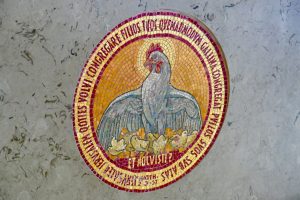HOMILY WEEK 30 04 – Year II
Putting on the Armour of God
(Eph 6:10-21; Ps 144; Lk 13:31-35)
************************************
“Get away from here, for Herod wants to kill you!”
According to the New Interpreter’s Bible, these are fateful words. Even though Luke here puzzlingly paints a more positive picture of the Pharisees than the other gospels – they might even be genuinely concerned for Jesus – these words clarify both the fate of Jesus and that of Jerusalem.
With the readings today, they encourage us to be strong in faith, put on the armor of God, and become a source of hope for our wounded world.
Jesus will be killed as a prophet in Jerusalem which rejects and kills him and will be abandoned until it sees Jesus as the Son of Man. As a representative of the powerful who oppress God’s people, Herod is depicted as a devouring fox. Herod’s desire to kill Jesus, on the other hand, fits the characterization of the man to this point.
However, Herod will not hinder Jesus from completing his work. These verses assert that Jesus will finish his divinely appointed mission in Jerusalem. His statement about completing his work on the third day, that prophets are killed in Jerusalem, that they will next see him when he is proclaimed as the “blessed one who comes in the name of the Lord” is a reference to his Palm Sunday entrance to Jerusalem leading to his passion, death and resurrection. Through the fidelity of Jesus to God’s mysterious ways and to his passion, God would redeem the world.
Jesus journeys to Jerusalem as a prophet under the direction of God. Among the prophets killed in Jerusalem were Uriah, Naboth, Zechariah, those killed by Manasseh and in later legend, Isaiah (34-35). These words have a parallel in Matthew 23. References to Jerusalem mark the beginning, middle and end of Luke 13. The repeated address “Jerusalem, Jerusalem” is reminiscent of divine addresses in the Old Testament.
The metaphor of Jerusalem as mother and her inhabitants, or all Israel, as children is rooted in the Old Testament. Jesus, perhaps speaking as the Wisdom of God, has repeatedly offered Israel, God’s people, his motherly love and protection, but they would not receive him. The result is that Israel’s house is forsaken. Jerusalem would be destroyed by the time Luke wrote his gospel. Jesus looks ahead to his coming as the Son of Man at the end time.

Mosaic in the Dominus Flevit Church in Jerusalem
In his commentary on this gospel, Bishop Robert Barron states that as the theologian N.T. Wright points out, Jesus comparing himself to a mother hen who longs to gather her chicks under her wing, is much more than a sentimental image. It refers to the gesture of a hen when fire is sweeping through the barn. In order to protect her chicks, she will sacrifice herself, gathering them under her wing and using her own body as a shield.
On the cross, Jesus used, as it were, his own sacrificed body as a shield, taking the full force of the world’s hatred and violence. He entered into close quarters with sin (because that’s where we sinners are found) and allowed the heat and fury of sin to destroy him, even as he protected us.
With this metaphor in mind, we can see, with special clarity, why the first Christians associated the crucified Jesus with the suffering servant of Isaiah. By enduring the pain of the cross, Jesus did indeed bear our sins; by his stripes we were indeed healed.
In the first reading, St. Paul also addresses the problem of evil and darkness symbolized in the gospel by Herod, only Paul identifies that darkness and evil as the “wiles of the devil” and as a spiritual battle against cosmic forces of darkness in the universe. In today’s terms, these could be called Marxism, communism, totalitarianism, oppressive regimes like North Korea and China, multi-national corporations flaunting ethical and environmental laws, blatant polluters of the earth, the culture of death, fake news, etc.
The magnitude of this struggle for St. Paul is not cause for despair, however, but for hope grounded in his faith in the love of God. Paul simply advises us to be ready to battle these spiritual forces by “putting on the amour of God” – to counter lies by living the truth, to counter doubt with complete faith in Jesus Christ, to counter perdition with salvation, to counter Satan and the devil by the power of the Holy Spirit and the Word of God. Staying intimately united with Jesus by praying in the Spirit, we will have the power to be light in the darkness, a source of hope in a world full of despair.
The Eucharist is our best armour. We listen to the Word of God, are filled with the unconditional love of God, and commune with the body and blood of Jesus through the power of the Holy Spirit. May our celebration give us strength to resist temptation, overcome any darkness, and be a source of light and hope for our wounded world.



